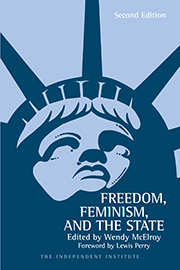Bill Clinton has long enjoyed the support of prominent feminists. They not only know a political ally when they see one; they recognize that many of Clinton’s detractors are actually attacking sexual harassment laws. But, in light of the Clinton sexual scandals, some, like Anita Hill, fear the laws may be weakened. Indeed, this may be the only happy outcome of an otherwise dreary episode.
When government punishes sexual attitudes, as opposed to crimes against person and property, it interferes with personal freedom and steps beyond the bounds of good law. What’s more, when government imposes a social agenda onto the business realm, it deprives everyone of the right to contract freely. In a truly free economy, these laws simply would not exist.
Other commentators offer a different reaction. Lorna Brett, president of the Chicago Chapter of the National Organization for Women, had to defend NOW against the charge of being “the president’s lap dog” for failing to denounce Clinton. And when the New York Observer reprinted a candid conversation about Monica Lewinski between “lipstick feminists” Nancy Friday and Katie Roiphe, the eavesdropping revealed not concern for women but salacious snickering.
As the accusations against Clinton became more credible with Kathleen Willey’s claims to have been harassed, the snicking softened. If her charges are true, NOW spokeswoman Patricia Ireland then said, Clinton is not just guilty of sexual harassment (abusive comments and proposals), but also assault (unwanted physical contact), which is a criminal charge.
Amidst the growing cacophony, one feminist statement on the Clinton scandal assumes particular importance: namely, a New York Times piece by Chicago law professor Catharine A. MacKinnon (“Harassment Law Under Siege”). For more than a decade, MacKinnon has been a defining voice within feminist theory. For example, she was pivotal in convincing the legal establishment that sexual harassment should be viewed as sexual discrimination under Title VII, the “fair-employment” provision of the 1964 Civil Rights Act.
MacKinnon’s article, a defense of sexual harassment laws, cries out for analysis and rebuttal. In filtering the Monica Lewinski debacle, MacKinnon makes an essential distinction repetitively clear. In a short op-ed she uses the phrases “sexual harassment in the workplace,” “sexual abuse at work,” “sexual harassment at work,” “subordinate to the same man at work,” and “harassment at work by law.”
The distinction here is between harassment at work and harassment at “school.” Although MacKinnon acknowledges that “being an intern at the White House was more like being at school than at work,” she says both Lewinski and Jones “were women subordinate to the same man at work.”
Harassment in the workplace is defined in one of two ways: (1) a quid pro quo, by which sexual favors are directly traded for professional gain or against a threat of professional loss; and (2) “a hostile working environment”—a phrase coined by MacKinnon—in which women are threatened and “disempowered.” Neither definition seems to cover eagerly rendered sexual favors, which is the worst scenario suggested thus far in the Bill and Monica soap opera.
Harassment in a school environment is defined differently.
In Sexual Harassment: Confrontations and Decisions—an anthology which includes two MacKinnon essays—Nancy Tuana contends that even innocent academic meetings can be coercive because of the power differential between a professor and student. Tuana calls this harassment an “implicit unintended threat, [with] no intention to harm.”
Universities have scrambled to prevent such harm. For example, in September 1989, Harvard issued a guideline stating that innocent remarks could constitute harassment: “Alienating messages may be subtle and even unintentional, but they nevertheless tend to compromise the learning experience of both sexes.... For example..., calling only upon women in a class on topics such as marriage and the family.”
In a school environment, harassment tends to be divorced from intention; instead, it speaks to power differentials. If an internship at the White House can be seen as a student relationship rather than an employment one, the question of sexual harassment in the Lewinski scandal becomes far more debatable. It is a debate from which MacKinnon wishes to flee.
What, then, about Willey? She was a volunteer when the alleged abuse occurred. That leaves open the question of whether feminists should apply employment criteria or learning environment ones to determine the presence of sexual harassment. Although Ireland pointedly calls the alleged abuse “sexual assault” and not harassment, this is far from clear. Some commonly cited definitions of harassment encompass assault (see F.J. Tilly’s 1980 report to the National Advisory Council of Women’s Educational Programs).
Faced with the possible intellectual demise of sexual harassment laws, MacKinnon wishes to protect them by defining the Lewinski situation as a work environment, even though she was not an employee. Ireland would protect sexual harassment laws by defining the Willey situation as sexual assault.
But neither approach is satisfactory. Let me follow MacKinnon onto what, for her, is the less shaky ground of harassment in the workplace and argue for the repeal of current laws. I detest the attitudes some men express toward women in the workplace. But the essential question is this: should the government mandate social and sexual attitudes and mores?
More fundamentally: what is the purpose of law in society? Should it enforce a politically driven perspective on what constitutes virtuous thought and action? That is far too broad a mandate to be compatible with freedom. Law should protect rights: that is, law should prevent and redress acts of violence against person and property. It should not address peacefully expressed conduct, much less presume to police attitudes, however offensive they may be.
Sexual harassment laws are enforced at a moral cost. They do damage to the freedom of speech. They invade privacy. They glorify the government as parental guardian. And the economic costs are immense. An estimated 75 percent of American companies have instituted sexual harassment policies. These businesses spend huge amounts of money to educate employees on this issue, to settle lawsuits and prevent such suits from occurring. There are subtle social costs of sexual harassment laws as well. The laws cast women as permanent victims, and causes them to lose male mentors who fear prosecution. The laws tend to harden the attitudes they are intended to change.
True sexual harassment involves physically invasive behavior. When assault or battery occurs, women should have the opportunity to press criminal charges. When the harassment is verbal, women must be free to confront verbal abuse and refuse to tolerate it. And women should use remedies that almost every company has as a matter of internal policy. In a market economy, there is competition for work environments among firms. But with regulations superimposed on the market, most of the women who report harassment to researchers and the government say they never complained to their employers.
A key to resolving the sexual harassment issue is to return it to the realm of tort law, which provides civil redress for private harms. The courts have a long history of viewing unwanted sexual contact as tortious—usually when it is expressed in the form of battery or assault, as Clinton’s forced fondling of Willey would constitute. Most feminists, however, resist the return to tort law because it would make sexual comments and propositions unactionable unless accompanied by physical trespass.
What does it say for sexual harassment laws when most people believe Clinton has committed some form of sexual assault but that the offender should remain unpunished? What happens to the law when people sympathize more with the sexual abuser than with the victims?
Contra the mainstream feminist lobby, sexual harassment laws are no longer tenable. Yet there remains an undeniable problem of women not being treated properly in many realms, including work. Government is not the solution; it’s the problem. Do we need to look farther than Clinton to see this principle in action?









